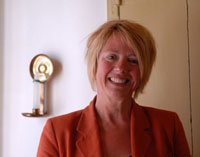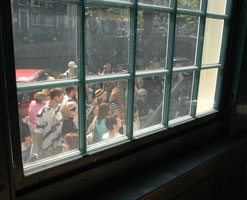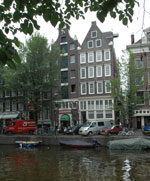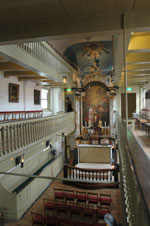Our Lord in the Attic: A Case Study
Our Lord in the Attic: a case study
![]() Tutorial: use of this web site (Power point presentation, 6MB)
Tutorial: use of this web site (Power point presentation, 6MB)
Museum Our Lord in the Attic is the building on the left of the alley.
View of the church from the first gallery.
![]() Mission statement (PDF, 118 KB)
Mission statement (PDF, 118 KB)
Introduction
 |
Welcome to Museum Ons’ Lieve Heer op Solder (Our Lord in the Attic). My name is Judikje Kiers and I am the director of this small, but unique historic house museum, which lies in the heart of the oldest part of Amsterdam, the capitol of the Netherlands. Our museum gives visitors a glimpse of the Dutch Golden Age - visitors step back in time almost 350 years as they walk through this rare example of a rich merchant’s home, through rooms, corridors and up and down steep stairs. From the outside the building looks just like any other 17th century Dutch canal house, but its attic holds a unique treasure: a Catholic church built in the early 1660’s. This once clandestine church is still in use today.
Visitors react with surprise and amazement to the tangibility of the history surrounding them here. Everything is genuinely old, and that gives it a special feel. The building has preserved its 17th century atmosphere, at the same time it tells a story of continual adaptation and modernization. The history of the clandestine church is told by a host of original details. Each century has left traces of the changes made as the rooms were put to a variety of uses. The Museum Ons’ Lieve Heer op Solder is indeed a historical experience. Even so, the monument is more than just a collection of rooms and objects of historical value. The ensemble offers a unique opportunity to inform visitors about religious freedom – and inevitably, religious discrimination – about dealing with diversity, about the atmosphere of tolerance prevailing in Amsterdam, and about Catholic traditions and the lives of ordinary citizens in the Dutch Golden Age.
 We are a popular museum with visitors from all over the world. In recent years we have seen our visitor numbers increase rapidly from 57,000 in 2000 to approximately 90,000 in 2006. This is in itself wonderful as it allows us to reach out to a larger audience, telling the history of religious tolerance. As a matter of fact, the theme of Ons’ Lieve Heer op Solder is more current than ever, for this once clandestine church epitomizes the present-day challenge of coping with religious and cultural diversity in our society.
We are a popular museum with visitors from all over the world. In recent years we have seen our visitor numbers increase rapidly from 57,000 in 2000 to approximately 90,000 in 2006. This is in itself wonderful as it allows us to reach out to a larger audience, telling the history of religious tolerance. As a matter of fact, the theme of Ons’ Lieve Heer op Solder is more current than ever, for this once clandestine church epitomizes the present-day challenge of coping with religious and cultural diversity in our society.
We are fortunate in the public interest shown in Our Lord in the Attic. Ironically, however, it is our many visitors who are inadvertently destroying the very fabric of the building. Not only do they cause wear and tear to the historic floors and stairs, but their mere presence influences the climate inside the building, causing damage to the art works and to the most important object of all – the building itself. In recent summers (which have been hotter then normal), our busiest time of the year, we noticed that visitors do not feel comfortable in the church, especially during events such as weddings and mass. Another recent incident, where a visitor slipped down the stairs spraining an ankle, made us aware of the issue of visitor safety. You must realize that this house has the typical narrow and steep stairs so common in old Dutch houses—these are indeed difficult to climb.
My staff and I are responsible for the safekeeping of this important monument with its interiors and collection as well as keeping it alive. Our mission requires us to balance preservation with access. However, increasing visitation levels have challenged our efforts for conservation and for ensuring visitor enjoyment of the museum. We asked advice from the Netherlands Institute for Cultural Heritage (ICN) and the Getty Conservation Institute (GCI) to help find this balance. Over two years they assessed the indoor climate, the condition of the collection and the building, the impact of visitors and also looked at visitor comfort.
In a few years the monument will celebrate its 350th anniversary, a special occasion. But the years have taken their toll: the building is in need of repair, and the modern facilities required by a functioning museum obscure its historical aspects. Torn between the need to conserve the building and the desire to embrace its potential as a public attraction, we are struggling to let this centuries-old monument radiate its special significance. If we want future generations to have the privilege of visiting Our Lord in the Attic, and if we wish to keep the building open to the public while preserving its value as a monument, we must seek solutions to the problems outlined above. Now is a good time as we are planning to refurbish the museum, which will involve the careful restoration of the church and some of the other rooms. There are also plans to expand the museum.
How can you help?
The museum would like to implement a management strategy in which the issues of building maintenance and collection care are balanced with visitor comfort and accessibility. We are concerned both for the impact that visitors have on the building and the indoor climate - which will affect the preservation of our collection. Should we be doing something to improve the indoor climate both for the preservation of the collection as well as make it more comfortable for visitors? How many visitors can we allow access per year and how many can we safely handle for special events? In other words - what is our carrying capacity? The decisions we may have to take inevitably will lead to conflicts.
We are interested to hear from you what you would advice from your area of expertise. I have asked my staff to provide you with information about our museum, the building and the collection. It includes what we know of the history of the building and the history of the museum. We also make available the research data generated by ICN and the GCI. All this information may be used by you and has been made accessible through this Web site. We trust that you will treat this information confidentially.
I look forward to hearing your advice.

